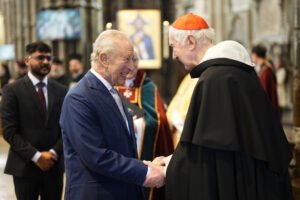The Controversy of Artwork at the Catholic Shrine in Lourdes: A Priest’s Legacy Under Scrutiny
Introduction to Lourdes and Its Significance
Lourdes, a small town nestled in the foothills of the Pyrenees in southwestern France, has garnered immense significance within the Catholic community as a premier pilgrimage destination. The site became renowned following a series of events in 1858 when Bernadette Soubirous, a young peasant girl, reported eighteen apparitions of the Virgin Mary. These miraculous encounters led to the proclamation of the Marian Shrine of Our Lady of Lourdes, transforming it into a major pilgrimage site that draws millions of visitors each year from around the globe.
The historical context of Lourdes is deeply intertwined with the themes of faith, hope, and healing. Pilgrims flock to the shrine seeking physical and spiritual renewal, inspired by the belief in the miraculous healing properties of the waters that flow from the Grotto of Massabielle. The sanctity of these waters has been substantiated by numerous documented cases of inexplicable healings, which the Catholic Church has meticulously investigated. Consequently, Lourdes has evolved into a place of refuge for the sick and the suffering, establishing its reputation as a locus of divine intervention.
The significance of Lourdes extends beyond its role as a religious center; it represents a confluence of faith and community, where visitors partake in a shared experience of devotion. The annual influx of pilgrims reflects a sustained commitment to the values and traditions of Catholicism, anchoring the town in a rich tapestry of faith-based narratives. Thus, as the pilgrimage continues to grow in both scale and international reach, Lourdes remains a focal point of Catholic devotion, profoundly influencing the lives of those who visit in search of solace and affirmation of their beliefs.
The Artwork in Question
The artwork created by the priest accused of misconduct at the Catholic Shrine in Lourdes has drawn significant attention and controversy. Predominantly characterized by its vibrant colors and intricate details, these pieces reflect a blend of classical religious themes and the unique cultural aspects of the region. The artist’s work often features iconic biblical scenes, meant to inspire contemplation and devotion among pilgrims visiting the shrine. These artworks serve not only as visual representations of faith but also as a conduit for spiritual reflection, inviting worshippers to engage more deeply with their beliefs.
The themes encapsulated in the artwork emphasize key aspects of Catholic doctrine, portraying figures such as the Virgin Mary and various saints, framed within the serene and picturesque backdrop of Lourdes. This setting adds depth to the emotional resonance of the pieces, as they draw connections between the earthly and the divine. For many pilgrims, the artwork acts as a focal point during their visit, encouraging moments of prayer and meditation. The role of these visual elements within the shrine is profound, as they augment the spiritual atmosphere and help facilitate a connection with the sacred.
The Allegations Against the Priest
The case surrounding the priest who created the artwork at the Catholic Shrine in Lourdes has garnered significant attention, shedding light on a complex interplay between religious devotion and the distressing allegations of abuse. The priest, whose identity has been linked to several commendable artistic contributions to the shrine, now finds his legacy overshadowed by serious accusations that surfaced in recent years.
Allegations against the priest include claims of inappropriate behavior and abuse spanning several decades. Reports emerged from various sources, including former parishioners and individuals connected to his ministry, alleging that the priest engaged in misconduct that deeply impacted the lives of those involved. These allegations trigger a profound conversation about accountability within the Church, particularly in relation to sexual abuse, a topic that continues to spark both outrage and concern among the faithful.
A timeline of events regarding these allegations is essential to contextualize the scrutiny that the priest now faces. In early 2021, the first accusations were brought to light, prompting both local media coverage and a broader societal outcry. In the months that followed, more individuals came forward, detailing their experiences and seeking justice. The Catholic Church responded by initiating an internal investigation, which aims to thoroughly examine the allegations while maintaining sensitivity to the victims’ experiences.
In the wake of these claims, it is crucial to handle the discussion with care, considering the emotional and psychological ramifications for all parties involved. The legacy of the priest, once celebrated for his artistic contributions, is now a subject of heated debate, raising critical questions about the promises of protection, transparency, and healing in a religious context. As the investigation unfolds, the Church is challenged to navigate these sensitive matters with the utmost gravity, seeking a balance between its historical values and the urgent need for accountability.
Reactions from the Church and the Community
The accusations surrounding the artwork at the Catholic Shrine in Lourdes have sparked a complex array of reactions from both Church officials and the local community. In the wake of these allegations, the Church has maintained a stance of careful deliberation, issuing statements that underscore a commitment to transparency while also reflecting a desire to safeguard the reputation of the institution. Recent communications from the Diocese have emphasized the investigation’s significance, asserting that it will be conducted with both rigor and sensitivity. This approach has been met with mixed reactions from the congregation and the wider community.
Within the Church, some officials have publicly supported the priest in question, expressing a belief in his integrity and the need for due process. This perspective has garnered support from a portion of the parishioners, who argue that allegations should not tarnish the legacy of his service and dedication. However, this support is not universal. Many community members have voiced their outrage, calling for accountability and change within the Church. The artistically controversial nature of the artwork itself has raised deeper concerns regarding its appropriateness and the messages it conveys, igniting discussions about artistic freedoms versus doctrinal integrity.
The local community’s response has been notably passionate, with some individuals organizing forums to discuss the implications of the allegations. These gatherings have facilitated a broader dialogue on how the Church should address such matters and what reforms may be necessary to foster trust and transparency. Advocacy groups have also begun to weigh in, arguing that the Church’s response to this situation could set a significant precedent for how similar allegations are processed in the future. Balancing the diverse voices of support and dissent remains a challenging task for Church leaders, as they strive to navigate this deeply contentious issue.
The Place of Art in Religious Spaces
Art plays a multifaceted role in religious environments, acting as a vital conduit for faith, reflection, and inspiration. Throughout history, religious art has served not only as a means of aesthetic appreciation but also as a deeply ingrained part of worship and community identity. Artistic representations of sacred narratives provide worshippers with tangible connections to their beliefs, allowing them to engage with the divine through visual storytelling. In this context, the presence of artwork within religious spaces enhances the spiritual atmosphere, fostering an environment conducive to contemplation and devotion.
However, the inclusion of controversial figures’ works can complicate this dynamic. When artwork in religious spaces is associated with contentious or debated legacies, it raises questions about the role of art as a tool for spiritual edification versus its potential to incite discord among believers. This tension is particularly evident in places like Lourdes, where the significance of artistic expression is often weighed against the values and historical narratives it represents. Controversial artworks can challenge congregants to confront uncomfortable truths about morality, ethics, and the complexities of faith, which may lead to a richer dialogue or, conversely, to conflict and division.
Furthermore, the interpretation of art within religious contexts is subject to personal and collective experiences, which informs how congregants engage with these works. Artworks that once inspired reverence may evoke questions about authenticity, morality, and intention, transforming their role from inspirational to provocative. As such, the place of art in religious spaces like Lourdes is not merely about visual appeal; it encompasses the broader implications of societal values, individual beliefs, and historical narratives, pushing congregants to reconcile their faith with the complex legacies of those who created these works. Thus, the interaction between art and faith continues to be a salient topic for discussion in today’s religious discourse.
Impact on Pilgrimage and Visitor Experience
The controversy surrounding the artwork at the Catholic Shrine in Lourdes has undeniably affected the pilgrimage experience for many visitors. Pilgrims who come to Lourdes are often seeking spiritual solace and healing, hoping to reconnect with their faith in a sacred environment. The presence of art carries significant meaning in this context, as it can enhance the spiritual atmosphere and contribute to the emotional and psychological experiences of the pilgrims. However, with the allegations against the artist–a priest of the shrine–the perception of these artworks has shifted, leading to a nuanced experience for many pilgrims.
Some visitors may find it challenging to reconcile their admiration for the artwork with the moral implications of the controversy surrounding its creator. This duality can lead to a conflict within the pilgrimage experience, where visitors may feel uneasy or distracted by thoughts about the allegations rather than being fully present in their spiritual journey. Moreover, this situation has prompted discussions among pilgrims regarding the nature of artistry and its creator—wondering whether the spiritual significance of the art is diminished by the unsavory reputation of the priest.
The impact is also evident in the behaviors and interactions of visitors. Some may choose to avoid certain pieces of artwork altogether, preferring to focus on elements of the shrine that are free from controversy. Conversely, others may seek to engage in dialogue with fellow pilgrims about the allegations, thereby altering their experience through shared reflections and perspectives. The reactions vary widely based on personal beliefs and experiences, highlighting that the controversy has created a more complex landscape for pilgrims.
Ultimately, while the artworks at Lourdes still hold aesthetic and spiritual vitality, the ongoing examination of the priest’s legacy has undeniably influenced the way that they are appreciated and encountered by visitors. This evolving perception contributes to a dynamic pilgrimage experience, one that is marked by both reverence for the sacred and awareness of human fallibility.
Calls for Accountability and Change
The recent scandals concerning allegations of abuse within the Catholic Church have ignited a fervent demand for accountability and reform, particularly in relation to the situation at the Shrine in Lourdes. Advocacy groups and individual activists have increasingly called upon Church leadership to address these allegations transparently and honorably. The pressing nature of these calls highlights not only the urgency of rectifying past injustices but also the necessity for systemic change within the institution.
Among the primary demands is for the Church to implement more robust processes for reporting and addressing allegations of abuse. Many advocates argue that the current measures are insufficient, often leading to cover-ups rather than genuine investigations. This lack of transparency has fueled skepticism among the laity and diminished trust in Church authorities. As similar instances, both historical and contemporary, continue to surface, the case at Lourdes exemplifies a broader culture that requires deep evaluation and restructuring to ensure accountability.
Furthermore, various groups have emphasized the necessity for institutional reforms that not only address individual cases but also create a safer environment for the faithful. These reforms could include introducing policies to protect whistleblowers, regular audits of Church practices regarding abuse, and increased training for clergy on safeguarding measures. By adopting such comprehensive strategies, the Church could foster an atmosphere that prioritizes the welfare and dignity of its community members.
The outcry for change serves as a reminder of the larger issues facing the Catholic Church. The situation at Lourdes is not an isolated incident; it is indicative of systemic problems that have long plagued the institution. Consequently, addressing these concerns requires not just local action but a committed, global response to reshape the environment of trust and safety within the Church, transforming it into a place of healing and hope for all its members.
The Role of Artistic Expression in Healing and Forgiveness
Art has long been regarded as a powerful medium for expressing complex emotions, and in the context of the church’s abuse crisis, its role takes on an even deeper significance. Artistic expression can facilitate healing and forgiveness, serving as a conduit for individuals and communities grappling with profound trauma. Within religious settings, where faith often intertwines with personal narratives, art can become a vital tool for processing shared hardships and fostering a sense of understanding and reconciliation.
The creative process enables those affected by trauma to articulate their feelings in ways that mere words may fail to encapsulate. Thus, artworks can convey the nuanced journey toward healing, portraying not just the pain of past abuses but also the resilience and hope for the future. By engaging with visual arts, music, or literature, individuals may find a safe space to confront their experiences. This act of creation, whether through painting, writing, or performing, can evoke a cathartic release, allowing for forgiveness and a pathway toward renewal.
Moreover, community art initiatives can serve to fortify collective healing. By inviting collaboration among survivors and artists, these initiatives foster a shared narrative that honors the pain while also illuminating the possibility of redemption. Such artistic endeavors reinforce community ties, creating environments conducive to solidarity and support. Through exhibitions or performances that integrate themes of sorrow and hope, the community can engage in difficult dialogues, ultimately finding strength in vulnerability.
In juxtaposing the beauty of art with the harsh realities of historical transgressions, communities can navigate their painful truths with compassion. This reconciliatory process does not diminish the gravity of past injustices; rather, it highlights the potential for transformation through beauty and creativity, providing a pathway to healing and forgiveness.
Conclusion: Navigating Faith and Controversy
As we reflect upon the complex nature of faith and the controversies surrounding artwork at the Catholic Shrine in Lourdes, it is essential to recognize that these dilemmas challenge not only individual beliefs but also communal identities. The scrutiny of a priest’s legacy, intertwined with artistic expression, brings to light the delicate balance that religious communities must strike as they navigate their faith in a changing moral landscape.
The contemplation of art within religious spaces reveals that such expressions can carry significant burdens, especially when associated with figures who may have fallen from grace. In addressing these controversies, communities are often faced with a dual responsibility: to honor their spiritual heritage while also ensuring accountability against actions that may contradict fundamental moral values. This intersection prompts a broader dialogue on how faith communities can forge pathways toward healing, recognizing the multifaceted roles of art as both a spiritual tool and a possible source of dissent.
Amid challenges, the importance of open dialogue emerges as a vital mechanism for navigating disagreements. Encouraging discussions within the community allows for diverse perspectives to be heard, fostering understanding and potentially leading to collective healing. This engagement must be approached with sensitivity, acknowledging differences in individual experiences and interpretations of faith. In light of recent events, it becomes clear that a united approach to accountability and healing can also allow for spiritual growth and renewal.
Ultimately, navigating the complexities of faith amidst controversies calls for a careful examination of how art, representation, and legacy impact communities. It is through this introspection and collective effort that religious organizations can aspire to embody the principles of love, compassion, and integrity that are central to their beliefs, promoting a more inclusive environment capable of withstanding adversity.










Leave a Reply
You must be logged in to post a comment.